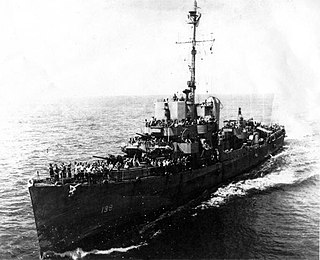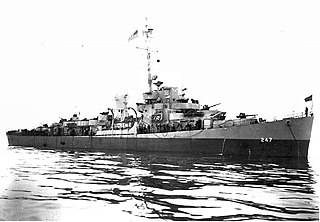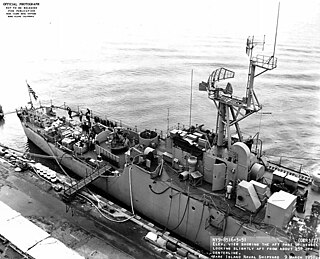
USS Greene (DD-266/AVD-13/APD-36) was a Clemson-class destroyer in the United States Navy in service from 1919 to 1922. She was recommissioned in 1940 and wrecked in a storm in October 1945.

USS Spangenberg (DE/DER-223), a Buckley-class destroyer escort of the United States Navy, was named in honor of Gunner's Mate Kenneth J. Spangenberg (1922-1942), who died as a result of wounds suffered during the Naval Battle of Guadalcanal, while serving aboard the heavy cruiser San Francisco (CA-38). He was posthumously awarded the Navy Cross.

USS Stewart (DE–238) is an Edsall-class destroyer escort, the third United States Navy ship so named. This ship was named for Rear Admiral Charles Stewart, who commanded USS Constitution during the War of 1812. Stewart is one of only two preserved destroyer escorts in the U.S. and is the only Edsall-class vessel to be preserved. She is on display in Galveston, Texas as a museum ship and is open to the public.

USS Huse (DE-145) was a U.S. Navy destroyer escort launched by Consolidated Steel Corp., Orange, Texas on 23 March 1943, during World War II. The ship was sponsored by Mrs. L. M. Humrichouse, daughter of Admiral Harry McLaren Pinckney Huse, whom the ship was named after and commissioned on 30 August 1943.

USS Jacob Jones (DE-130) was an Edsall-class destroyer escort built for the U.S. Navy during World War II. She served in the Atlantic Ocean and provided destroyer escort service against submarine and air attack for Navy vessels and convoys.

USS Farquhar (DE-139) was an Edsall-class destroyer escort in service with the U.S. Navy from 1943 to 1946. She was scrapped in 1974.

USS J.R.Y. Blakely (DE-140) was an Edsall-class destroyer escort in service with the United States Navy from 1943 to 1946. She was scrapped in 1973.

USS Blair (DE-147) was an Edsall-class destroyer escort in service with the United States Navy from 1943 to 1946 and from 1951 to 1960. She was scrapped in 1974. Blair was named in honor of Chief Machinist's Mate Eugene Blair, who was awarded the Silver Star posthumously for his brave actions when his ship was attacked and bombed by Japanese planes near Port Darwin, Australia, in mid-February 1942.

USS Tomich (DE-242) was an Edsall-class destroyer escort in service with the United States Navy from 1943 to 1946. She was scrapped in 1974.

USS J. Richard Ward (DE-243) was an Edsall-class destroyer escort built for the U.S. Navy during World War II. She served in the Atlantic Ocean the Pacific Ocean and provided destroyer escort protection against submarine and air attack for Navy vessels and convoys. She was named in honor of James Richard Ward who was awarded the Medal of Honor posthumously for his heroic efforts under fire on the USS Oklahoma (BB-37). She was launched by Brown Shipbuilding Co., Houston, Texas, 6 January 1943; sponsored by Miss Marjorie Ward, sister of Seaman First Class Ward; and commissioned 5 July 1943.

USS Otterstetter (DE-244) was an Edsall-class destroyer escort built for the U.S. Navy during World War II. She served in the Atlantic Ocean the Pacific Ocean and provided destroyer escort protection against submarine and air attack for Navy vessels and convoys.

USS Snowden (DE-246) was an Edsall-class destroyer escort built for the U.S. Navy during World War II. She served in the Atlantic Ocean the Pacific Ocean and provided destroyer escort protection against submarine and air attack for Navy vessels and convoys.

USS Stanton (DE-247) was an Edsall-class destroyer escort built for the U.S. Navy during World War II. She served in the Atlantic Ocean the Pacific Ocean and provided destroyer escort protection against submarine and air attack for Navy vessels and convoys.

USS Swasey (DE-248) was an Edsall-class destroyer escort built for the U.S. Navy during World War II. She served in the Atlantic Ocean the Pacific Ocean and provided destroyer escort protection against submarine and air attack for Navy vessels and convoys.

USS Howard D. Crow (DE-252) was an Edsall-class destroyer escort built for the U.S. Navy during World War II. She served in the Atlantic Ocean the Pacific Ocean and provided destroyer escort protection against submarine and air attack for Navy vessels and convoys.

USS Joyce (DE-317) was originally commissioned as a US Coast Guard Edsall-class destroyer escort built for the U.S. Navy during World War II. She served in the Atlantic Ocean and the Pacific Ocean and provided destroyer escort protection against submarine and air attack for Navy vessels and convoys. During its World War II service, on two different engagements with enemy submarines, the Joyce rescued survivors of the tanker SS Pan- Pennsylvania and its sister ship USS Leopold. Joyce received one battle star for its service during World War II.

USS Kirkpatrick (DE-318) was an Edsall-class destroyer escort built for the U.S. Navy during World War II. She served in the Atlantic Ocean the Pacific Ocean and provided destroyer escort protection against submarine and air attack for Navy vessels and convoys. Post-war, she was converted to a radar picket ship to support the DEW Line.

USS Strickland (DE-333) was an Edsall-class destroyer escort in service with the United States Navy from 1944 to 1946 and from 1952 to 1959. She was sold for scrapping in 1974.

USS Swenning (DE-394) was an Edsall-class destroyer escort in service with the United States Navy from 1943 to 1946. She was sold for scrapping in 1974.
USS Johnnie Hutchins (DE-360) was a John C. Butler-class destroyer escort acquired by the U.S. Navy during World War II. The primary purpose of the destroyer escort was to escort and protect ships in convoy, in addition to other tasks as assigned, such as patrol or radar picket. She served in the Pacific Ocean, and, post-war, she returned home with a Navy Unit Commendation awarded to her for her battle with Japanese midget submarines on 9 August 1945.



















